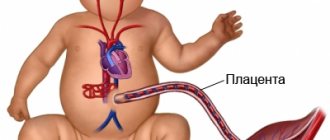Features of metrorrhagia are as follows:
- Bleeding in women occurs exclusively after the end of menstruation, or is completely unrelated to them,
- Intensity – from heavy discharge to minimal spotting elements.
Bloody discharge after the end of menstruation is one of the most common complaints about disorders of the reproductive system, requiring an early visit to the doctor for diagnosis and treatment.
Causes of metrorrhagia
Most often, when visiting a doctor, the following etiological factors are determined:
- Inflammation or infection of the genital area, when acute or chronic diseases cause disruption of the blood supply to the uterus and appendages,
- Incorrectly selected contraceptives,
- Diseases of the superficial layers of the uterus, as well as the muscular layer. Often the cause of “blooding” is endometriosis.
- Long-term pathological condition of the cervical area.
- Neoplasms of various types - benign tumors and oncological processes of the female genital area,
- Placement of the intrauterine device in a non-specific position or its individual rejection in certain positions,
- Disorder of ovarian activity - pathological and age-related changes in function.
- Consequences of gynecological operations and abdominal injuries.
- Decreased thyroid function.
- Nervous overload, emotional outburst, stressful situations
Clinicians classify bleeding that is associated with dysfunction of the appendages and can be of two types. Juvenile, occurring in girls and women of childbearing age and bleeding during the menstrual pause.
Bloody vaginal discharge 5 days after menstruation
Problems are indicated by bloody discharge that occurs after menstruation. If they begin 5 days after the end of the next critical days, then it is necessary to check whether there is pregnancy. In its absence, it is necessary to undergo a comprehensive examination. It is important to understand the hormonal background, look at the uterus and ovaries on an ultrasound.
If a dark brown secretion with pieces of mucous membrane comes out of the vagina, endometriosis may develop. Its foci will be visible during ultrasound diagnostics.
If your period has passed, but you still have spotting, then you need to check how the ovaries are functioning. The disorder can be caused by a malfunction of the thyroid gland. In the absence of gynecological problems, you can check how the blood coagulation system functions.
Bloody discharge, which is visible a week after menstruation, occurs due to microcracks in the vagina, erosion on the cervix or cervicitis. They are usually visible after sexual intercourse.
Read more about bleeding during reproductive age
Discharge of a small amount of blood is not yet uterine bleeding; after a certain time after the end of menstruation, it is quite often diagnosed in women and girls who do not suffer from certain pathologies of the genital area.
When bleeding occurs:
- The middle of the menstrual cycle is the period of the most active production of hormones, their level is maximum, which leads to some release of blood on the surface of the endometrium. Women who experience menstrual disorders should know that they do not last long, up to a maximum of three days. Blood began to flow, the volumes are constant and its appearance in this situation is not associated with pain. In cases where bleeding increases, discomfort appears, and then pain of various types, it is necessary to seek qualified medical help as soon as possible.
- There was a slight bleeding. Suddenly my period started. The appearance of a small amount of blood on underwear in the period two weeks and 15 days after the end of the menstrual cycle in women of reproductive age is often a sign that the female body has fulfilled its main function. The introduction of a fertilized egg into the mucous surface of the endometrium occurs in two days and is associated with a violation of the integrity of microcapillaries, which leads to the release of a small amount of blood from the uterus for a day or two. This phenomenon is not considered a pathology, and it cannot be treated.
The reason for this phenomenon is quite simple and completely physiological. Typically this type of bleeding is not heavy or prolonged. But there are many reasons when, against the background of general health, quite serious bleeding appears at various periods of the postmenstrual cycle.
How to stop
If women are bothered by regular bleeding after menstruation, they should consult a gynecologist.
Absolutely forbidden:
- take a hot bath;
- apply a hot heating pad or warming compress to your stomach;
- do douching.
If the blood released immediately after menstruation is large, complete rest is recommended. You need to lie down in bed with a pillow under your feet. You can put a cold, wet towel or ice on your stomach. It is advisable to restore lost fluid by increasing the volume of drinking. Sweet tea will replenish your glucose reserves. You can also brew and drink rose hips, which help improve blood clotting.
Taking calcium gluconate will help cope with bleeding. It will not only improve blood clotting, but also have a beneficial effect on the condition of blood vessels.
An effective remedy for reducing large volumes of blood is Vikasol. It replenishes vitamin K in the body, which is responsible for blood clotting. The effect of taking the drug does not occur immediately, but after only 10 hours. You can take 1 tablet before visiting the doctor, but be sure to inform the gynecologist about this.
Important! Under no circumstances should you even try to stop the bleeding using regular tampons. They will only interfere with the outflow of blood and can worsen the situation.
See also: How to understand bleeding or menstruation
Contraception and its impact
Mechanical devices - caps, spirals and their analogues can be one of the reasons that lead to quite serious discharge of blood with clots; it does not stop and can appear at any time after the end of menstruation.
Improper use of such drugs leads to the integrity of the blood vessels being damaged and bleeding, in which case it is necessary to visit a doctor.
If for some reason it is not possible to replace a contraceptive, you should get advice on their use.
Quite often, heavy bleeding and clots occur as a result of a woman wearing an intrauterine device; when discharge begins after the wearing period has expired, the elements of the device injure the endometrium.
Bleeding may occur as a consequence of the use of hormonal oral contraceptives.
In some situations, the need for urgent contraception again arises. The use of the drug "Postinor" leads to significant complications, among which the most common are painful bleeding.
Folk remedies
Recipes based on infusions and decoctions of medicinal herbs are used in gynecological practice to stop bleeding, but only after the recommendation of a gynecologist. Self-treatment can worsen the situation, since the woman does not know why the bleeding is occurring.
Of the herbs that stop uterine bleeding, the most commonly used are decoctions prepared on the basis of:
- Shepherd's purse and nettle. The effectiveness of plants is based on their blood thickening properties due to their high vitamin K content.
- Yarrow. Eating the herb contracts the muscles of the uterus, which also reduces bleeding.
- Horsetail. The aerial part has an astringent and anti-inflammatory effect.
- St. John's wort. The medicinal herb regulates the menstrual cycle, but use it with caution; in some cases, the opposite effect occurs and blood may flow more heavily.
Infusions of medicinal herbs are filled with biologically active substances and microelements, help fight inflammation, and support the immune system. Therefore, they can be used to treat gynecological problems, as an additional treatment, but only as prescribed by a gynecologist.
Bleeding due to pathologies
With the development of endometriosis, chronic endometritis, endometrial polyps, growth of the layers of the mucous membrane and muscles of the uterus is observed, which leads to heavy sudden bleeding with a large number of blood clots.
- Oncological processes in the genital area lead to a general deterioration in health, weakness, and decreased vitality. When women come to the doctor, they complain of constant severe pain in the lower abdomen and lumbar region, swelling of the legs and sudden disturbances in the digestive system.
- Disease of the thyroid gland with a significant decrease in its activity leads to frequent and heavy discharge. In addition to bleeding, the woman experiences apathy, fatigue, and loss of interest in life. Treatment in this case should be comprehensive - by a gynecologist and an endocrinologist at the same time.
- Bleeding from the urethra is characterized by insignificant discharge, the blood is brighter in color and more liquid in consistency, turning the urine reddish or brown. The appearance of blood in the urine indicates a pathological condition of the urinary system. The reasons for this phenomenon are inflammatory diseases of the urethra - urethritis, the presence of kidney stones, and the development of glomerulonephritis.
Therapy methods
Treatment of bleeding is based on the origins of the problem, the individual characteristics of the female body and the age of the patient. There are two directions in gynecological practice:
- Conservative therapy.
- To treat bleeding caused by hormonal imbalances, estrogen-progestogen drugs are prescribed to stop the bleeding and normalize the cycle.
- Measures also include taking hemostatic (hemostatic) agents or drugs that enhance the contractile activity of the myometrium (uterotonics).
- When diagnosing infectious or inflammatory processes, antibiotics, immunomodulators, and physiotherapy are prescribed locally and systemically.
- Surgical intervention. Used for growing fibroids and polyps. If a malignant tumor is detected, the oncologist will continue treatment.
In parallel with stopping the bleeding, measures are required to prevent relapses. A complex of vitamins is prescribed and anemia is treated. It is necessary to adjust the diet; to replenish blood loss, it is recommended to eat red meat and beef liver.
Ectopic pregnancy
Disturbance in the movement of a fertilized egg along physiological pathways, when the inability to enter the abdominal cavity leads to its attachment in a variety of places. Most often, having attached outside the uterus, the embryo begins to grow and develop.
This process continues until the growing embryo ruptures the fallopian tube or ovary, where it mainly attaches.
Such a rupture leads to large-scale bleeding, accompanied by dagger pain and loss of consciousness.
Ectopic pregnancy
Ectopic pregnancy according to the frequency of manifestation is distributed as follows.
| p/p | Name of naval base type | Signs and features |
| 1 | Pipe | The fertilized egg attaches to the wall of the fallopian tube. |
| 2 | Ovarian | The embryo chooses the ovary as its habitat. |
| 3 | Abdominal | The egg stops in the abdominal cavity, where it most often attaches to the peritoneum. |
| 4 | Pregnancy of vestigial horn | The rarest option, in this type, the embryo settles in a rudimentary horn. |
In the early stages, an ectopic pregnancy does not cause any discomfort to the patient. Most often, the first signs - malaise and pain in the side - simulate manifestations of appendicitis.
An ultrasound scan under the supervision of a gynecologist allows you to accurately diagnose a VMB. It definitely requires surgical intervention.
Treatment and prevention
Therapy for such disorders is exclusively symptomatic; it is first necessary to undergo an examination to determine the causes. The treatment tactics are chosen by the gynecologist after conducting all the necessary examinations.
In addition to a set of medications aimed at eliminating the etiology, the doctor prescribes general health-improving medications and vitamins. In case of heavy discharge, hospitalization is indicated.
It is practically impossible to foresee the possibility of an ectopic pregnancy. But regular visits to the gynecologist, examination and treatment of symptomatic diseases that cause the further development of intrauterine pregnancies.
Diagnostics
What to do if you are worried about bleeding after menstruation? There is only one answer: urgently go to the gynecologist. It is impossible to make a diagnosis yourself, so it is better to trust a specialist. After all, the appearance of uterine blood after menstruation has ended is sometimes a symptom of a serious illness, on which not only the future health, but also the life of a woman depends. The doctor will conduct the necessary examination and prescribe treatment measures.
To find out the causes of intermenstrual bleeding, the gynecologist prescribes a comprehensive examination, usually using the following procedures:
- Blood test: a study of general values gives an idea of the state of the body, reveals anemia and the presence of inflammation. Biochemical analysis informs about the operation of individual systems. Blood is taken to determine the concentration of hormones - a method that determines the functioning of the endocrine system.
- Hysteroscopy helps to detect pathology visually during a gynecological examination using optical equipment.
- Ultrasound of the uterus and surrounding space makes it possible to identify diseases of the organ at any stage of development.
- Examination of the smear under a microscope reveals an infectious infection.
- Colposcopy is performed for a detailed examination of the vaginal cavity and cervix with multiple magnification. If anomalies are detected, the doctor simultaneously performs a biopsy of the material for laboratory testing.
- Histological analysis is taken from the uterus, its cervix and cervical canal to identify oncology.
You should not refuse a thorough and comprehensive examination; if the doctor prescribes all measures at once, it means that he has reasons for this. Based on the diagnostic results, treatment will be carried out.











